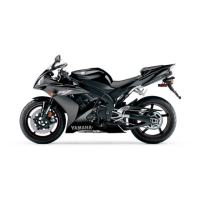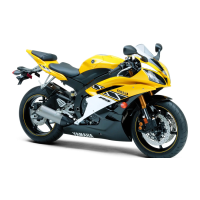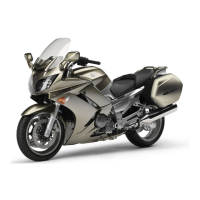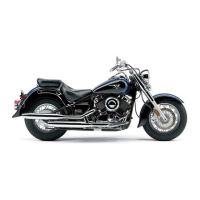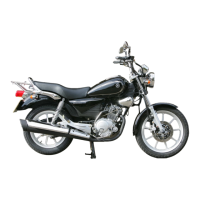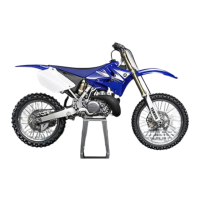Do you have a question about the Yamaha 2006 YBR125 and is the answer not in the manual?
Explains symbols like WARNING, CAUTION, and NOTE used throughout the manual for critical information.
Guidance on safe operation, visibility, operator qualifications, and hazard awareness.
Recommendations for helmets, clothing, and footwear to ensure rider safety.
Warnings against unauthorized modifications and guidelines for safely adding cargo or accessories.
Precautions for refueling, ventilation, and parking near hot components or flammable materials.
Identifies key parts and components visible from the left side of the motorcycle.
Identifies key parts and components visible from the right side of the motorcycle.
Identifies handlebar controls, levers, and dashboard instruments for operation.
Operation of the ignition, lighting, and steering lock functions for vehicle control.
Explanation of dashboard indicator lights and speedometer unit functions.
Details on how to read and use the speedometer, odometer, and trip meter.
Information on reading the tachometer, fuel gauge, and operating handlebar switches.
Operation of the clutch lever and shift pedal for smooth gear changes.
Instructions on how to operate the front brake lever and rear brake pedal.
Procedures for opening, closing, and refueling the fuel tank safely.
Information on the catalytic converter's function and fuel cock operation.
How to use the choke lever for starting a cold engine.
Using the kickstarter and adjusting rear shock absorber preload settings.
Information on the rear carrier, luggage holders, and sidestand operation.
Explanation of the ignition circuit cut-off system and its safety functions.
A comprehensive list of checks to perform before riding to ensure safety and proper function.
Step-by-step procedures for starting the engine under different temperature conditions.
How to shift gears for optimal control, acceleration, and climbing.
Tips for reducing fuel consumption and crucial procedures for engine break-in.
Correct methods for parking the motorcycle safely, considering hot components and ground stability.
Location and purpose of the tool kit included with the motorcycle for basic maintenance.
Schedule for regular inspections, adjustments, and lubrication of motorcycle components.
Procedure for inspecting, checking, and replacing the spark plug for engine health.
How to check the engine oil level and perform an engine oil change.
Steps for cleaning or replacing the air filter element to ensure proper engine performance.
Information on carburetor adjustment and setting the engine idling speed.
How to check and adjust the throttle cable free play for proper throttle response.
Checking tire condition, tread depth, and adjusting air pressure for safe operation.
Procedure to check and adjust the clutch lever free play for optimal engagement.
Checking and adjusting the front brake lever free play for proper braking.
Procedure for checking the wear on front brake pads and rear brake shoes.
How to check and maintain the front brake fluid level for effective braking.
Procedures for changing brake fluid and adjusting drive chain slack.
Proper methods for cleaning and lubricating the drive chain to prevent wear.
Checking the front fork for damage and smooth operation.
How to check for wear or looseness in the steering bearings.
Procedure for checking the condition and play of front and rear wheel bearings.
Checking and maintaining the battery's electrolyte level for optimal performance.
Locating and replacing fuses in the motorcycle's electrical system.
Step-by-step guide for safely replacing the headlight bulb.
Steps for safely removing and installing the front wheel for maintenance.
Procedures for safely removing and installing the rear wheel for maintenance.
A guide to diagnose and resolve common engine starting problems like fuel, compression, or ignition.
Special care instructions for maintaining matte finished parts to avoid damage.
Guidelines for cleaning the motorcycle after normal use and riding in adverse conditions.
Applying protection sprays and polishing metal parts to prevent corrosion and maintain appearance.
Instructions for storing the motorcycle safely for short and long periods.
Key physical dimensions, weight, engine type, displacement, and oil requirements.
Technical specifications for carburetor, spark plug, clutch type, and transmission.
Specifications for chassis type, tire sizes, brake types, and suspension systems.
Details on ignition system, charging system, battery, and lighting bulb specifications.
Recording key identification numbers for parts ordering and vehicle registration.
Location and importance of the model label for ordering spare parts.
Explains symbols like WARNING, CAUTION, and NOTE used throughout the manual for critical information.
Guidance on safe operation, visibility, operator qualifications, and hazard awareness.
Recommendations for helmets, clothing, and footwear to ensure rider safety.
Warnings against unauthorized modifications and guidelines for safely adding cargo or accessories.
Precautions for refueling, ventilation, and parking near hot components or flammable materials.
Identifies key parts and components visible from the left side of the motorcycle.
Identifies key parts and components visible from the right side of the motorcycle.
Identifies handlebar controls, levers, and dashboard instruments for operation.
Operation of the ignition, lighting, and steering lock functions for vehicle control.
Explanation of dashboard indicator lights and speedometer unit functions.
Details on how to read and use the speedometer, odometer, and trip meter.
Information on reading the tachometer, fuel gauge, and operating handlebar switches.
Operation of the clutch lever and shift pedal for smooth gear changes.
Instructions on how to operate the front brake lever and rear brake pedal.
Procedures for opening, closing, and refueling the fuel tank safely.
Information on the catalytic converter's function and fuel cock operation.
How to use the choke lever for starting a cold engine.
Using the kickstarter and adjusting rear shock absorber preload settings.
Information on the rear carrier, luggage holders, and sidestand operation.
Explanation of the ignition circuit cut-off system and its safety functions.
A comprehensive list of checks to perform before riding to ensure safety and proper function.
Step-by-step procedures for starting the engine under different temperature conditions.
How to shift gears for optimal control, acceleration, and climbing.
Tips for reducing fuel consumption and crucial procedures for engine break-in.
Correct methods for parking the motorcycle safely, considering hot components and ground stability.
Location and purpose of the tool kit included with the motorcycle for basic maintenance.
Schedule for regular inspections, adjustments, and lubrication of motorcycle components.
Procedure for inspecting, checking, and replacing the spark plug for engine health.
How to check the engine oil level and perform an engine oil change.
Steps for cleaning or replacing the air filter element to ensure proper engine performance.
Information on carburetor adjustment and setting the engine idling speed.
How to check and adjust the throttle cable free play for proper throttle response.
Checking tire condition, tread depth, and adjusting air pressure for safe operation.
Procedure to check and adjust the clutch lever free play for optimal engagement.
Checking and adjusting the front brake lever free play for proper braking.
Procedure for checking the wear on front brake pads and rear brake shoes.
How to check and maintain the front brake fluid level for effective braking.
Procedures for changing brake fluid and adjusting drive chain slack.
Proper methods for cleaning and lubricating the drive chain to prevent wear.
Checking the front fork for damage and smooth operation.
How to check for wear or looseness in the steering bearings.
Procedure for checking the condition and play of front and rear wheel bearings.
Checking and maintaining the battery's electrolyte level for optimal performance.
Locating and replacing fuses in the motorcycle's electrical system.
Step-by-step guide for safely replacing the headlight bulb.
Steps for safely removing and installing the front wheel for maintenance.
Procedures for safely removing and installing the rear wheel for maintenance.
A guide to diagnose and resolve common engine starting problems like fuel, compression, or ignition.
Special care instructions for maintaining matte finished parts to avoid damage.
Guidelines for cleaning the motorcycle after normal use and riding in adverse conditions.
Applying protection sprays and polishing metal parts to prevent corrosion and maintain appearance.
Instructions for storing the motorcycle safely for short and long periods.
Key physical dimensions, weight, engine type, displacement, and oil requirements.
Technical specifications for carburetor, spark plug, clutch type, and transmission.
Specifications for chassis type, tire sizes, brake types, and suspension systems.
Details on ignition system, charging system, battery, and lighting bulb specifications.
Recording key identification numbers for parts ordering and vehicle registration.
Location and importance of the model label for ordering spare parts.
| Engine Type | Air-cooled, 4-stroke, SOHC, 2-valve |
|---|---|
| Displacement | 124 cc |
| Bore x Stroke | 54.0 mm x 54.0 mm |
| Compression Ratio | 10.0:1 |
| Fuel System | Carburetor |
| Ignition | CDI |
| Transmission | 5-speed |
| Final Drive | Chain |
| Front Suspension | Telescopic fork |
| Rear Suspension | Swingarm |
| Front Brake | Single disc |
| Rear Brake | Drum |
| Front Tire | 2.75-18 42P |
| Overall Length | 1, 980 mm |
| Overall Width | 745 mm |
| Overall Height | 1, 080 mm |
| Seat Height | 780 mm |
| Wheelbase | 1, 290 mm |
| Ground Clearance | 175 mm |
| Fuel Capacity | 13 liters |
| Rear Tire | 90/90-18 |
